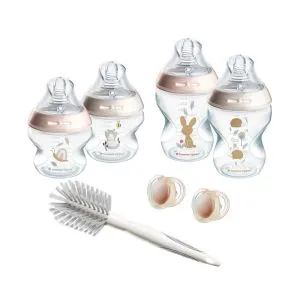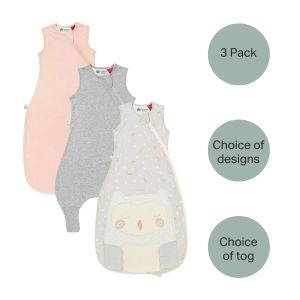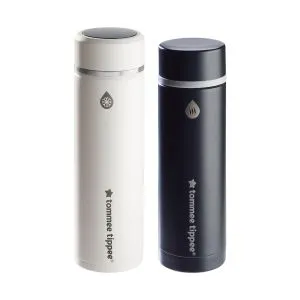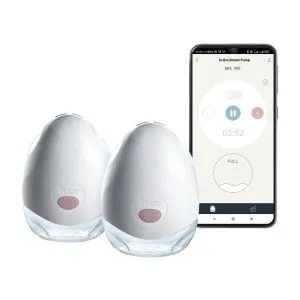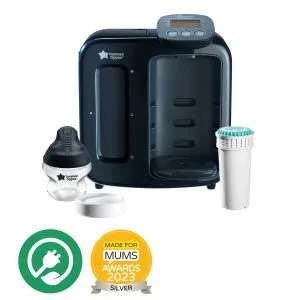
Tommee Tipps
Let’s run through what latching on means, cover how to achieve a comfortable breastfeeding latch, and discover how you can encourage your baby to latch deeper.
Breastfeeding: Latching On Guide
The truth is new parents often have lots of questions about latching on while breastfeeding!
A good latch is a key part of making sure that you're comfortable while feeding and that your baby feeds properly. So, let’s run through what latching on means, cover how to achieve a comfortable breastfeeding latch, and discover how you can encourage your baby to latch deeper.
Latch on: Meaning
Latching on is the process of getting your little one to suckle around your nipple and areola so they can breastfeed. Think of your areola as a target for your baby’s mouth and try to get them right in the bullseye! They should press against this target to trigger the milk flow and establish a strong milk supply.
If your baby is latched on properly, breastfeeding shouldn’t cause you discomfort, and your nipples won't become cracked or painful.
How to get a good breastfeeding latch
Getting the hang of a good breastfeeding latch that’s comfortable for you both can be a little tricky at first. It can take time and perseverance to get it all going smoothly!
Don’t stress and let us talk you through how to get a good latch:
- Let baby's head tilt back and brush your nipple against their lips.
- Try and let your little one find your nipple on their own. Put them in a comfy position where the nipple is close to their mouth and gently guide them there.
- Direct your nipple slightly above their top lip, and make sure their chin is not tucked down towards their chest.
- Aim their bottom lip away from your nipple’s base.
- Their lips should be turned outwards.
- They should lean into your breast with their chin first, open their mouth wide, and then latch on.
- Their chin should be firmly against your breast, with nothing against their nose.
- Baby’s tongue should be able to reach as much of your breast as possible and the areola (the circular, pigmented area around your nipple) should be in their mouth as well.
- Their cheeks should look rounded as they feed with a good latch.
Signs that your baby is latching on to your breast correctly
There are some signs to look out for that will let you know if your baby is latched on properly:
- Your baby’s lips should be flared out against your breast and not tucked in like they’re sucking on a straw. Remember, the gums and tongue do most of the work so your nipple should be deep into their mouth for a good breastfeeding latch.
- You should be able to hear or see them suck, swallow, and breathe in a steady pattern. Their chin and nose should be touching your breast, without squashing them.
- Breastfeeding shouldn’t be painful if everything is going to plan. If you’re experiencing pain in your breasts and especially your nipples, your baby might not be latched correctly and might be irritating your nipples.
- If your nipples are long and round after feeding, it’s likely that they were able to go deep into your baby’s mouth for a good feed. If you find that your nipple is flat or inverted, your baby may not have been able to get a good latch at that time.
Top breastfeeding latch tips
Getting a good breastfeeding latch can be difficult if you've got bigger boobs, but it should become easier with time. But if you’re finding it hard, try giving these breastfeeding latch tricks a try:
- If you’re struggling with getting a good latch, moving to a quiet place that you find calming can help. If you’re uncomfortable or stressed, your baby probably will be too.
- Hold your little one close and try using skin-to-skin contact to comfort them if they're feeling frustrated.
- Chat or sing to your baby as they feed to soothe them.
- It'll be easier to establish a deep latch if you feed your baby when they're calm and before they get too hungry.
- Try different breastfeeding positions to find which one works best for you both.
If these tips don’t help and you're still struggling to achieve a good latch or are concerned that your baby may be tongue-tied, consult your doctor or health visitor for advice.
Latching on FAQs
How can I get my newborn to latch deeper?
A deep latch can be achieved with any breastfeeding position. But it may help if you sit up straight, use pillows for support, and use the deep latch technique to prevent sore nipples and help your baby feed more easily.
Here’s a step-by-step guide to the deep latch technique:
- Hold your breast with your thumb and index finger on the edge of your areola and squeeze them towards each other.
- Support your baby's head with one hand, with your thumb near one ear, the third finger near the other ear, and the web of your hand at the nape of your baby's neck.
- Gently tip their head slightly backwards.
- When your baby’s head is back and their chin is up, you can lift them to your nipple. Your nipple should be resting above their upper lip.
- Wait for them to open their mouth wide. (You can encourage your baby to open their mouth wide to achieve a deeper latch by ticking their lips with your nipple.) You can then "scoop" your breast by positioning their lower jaw on the breast first. Next, tip their head forward and position their upper jaw behind your nipple.
- Wait for a few seconds, then you can let go of your breast. If your baby's nose is buried deep, simply tip their head slightly so you can see their nostrils.
What if I'm experiencing latch-on pain when breastfeeding?
If you think your baby isn’t latched correctly or if your nipple hurts when they're nursing, you can slide your finger into their mouth while they’re feeding to break the hold they have on your nipple. You can then try again and alter your position to achieve a better latch that’s more comfortable.
Don’t forget, it’s not supposed to be painful. You and your baby should be comfortable, and you should be able to see your little one sucking, swallowing, and breathing.
If you’re struggling at all, don't be afraid to ask for help. You can get in touch with your midwife or a lactation specialist. They'll be able to help you out with any breastfeeding-related issues.
How can I tell if my baby has a shallow latch?
A shallow latch is when a baby isn’t opening their mouth wide enough to nurse without causing pain to your breast. If you’re experiencing a shallow latch:
- Your nipples may be pinched, flattened, and squeezed.
- Feeding might be painful.
- You may find that your baby becomes frustrated or makes sucking movements. This is because a weak latch doesn’t allow them to feed properly.
- You may get a pinching feeling in the nipple during feeding.
- Your nipples might become sore, cracked, or scabbed.
What does a good latch mean?
A good breastfeeding latch is comfortable and pain-free for you and involves baby being positioned with their:
- chest and stomach against your body
- head straight
- chin touching your breast
- mouth open wide around the nipple and tongue cupped underneath it


